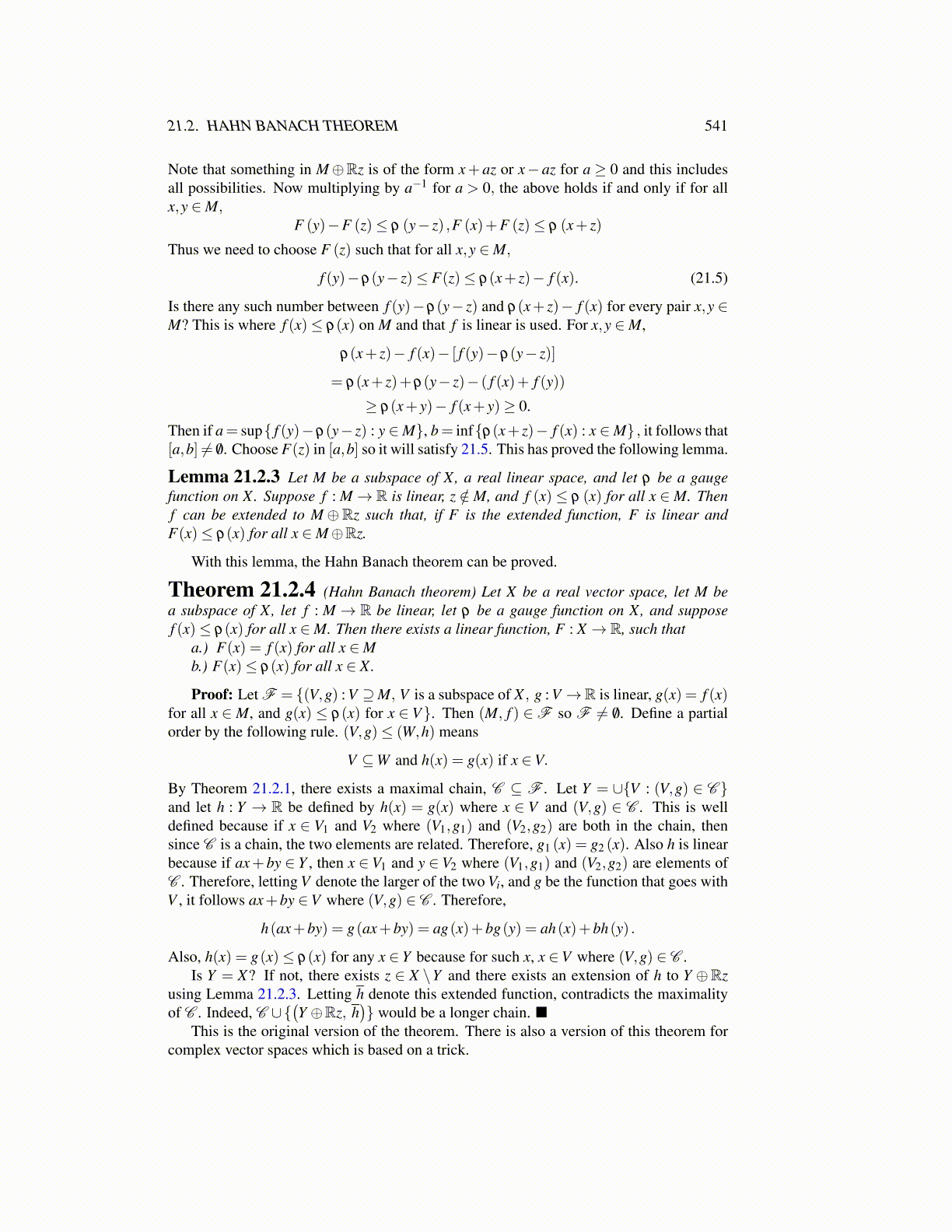
21.2. HAHN BANACH THEOREM 541
Note that something in M⊕Rz is of the form x+ az or x− az for a ≥ 0 and this includesall possibilities. Now multiplying by a−1 for a > 0, the above holds if and only if for allx,y ∈M,
F (y)−F (z)≤ ρ (y− z) ,F (x)+F (z)≤ ρ (x+ z)
Thus we need to choose F (z) such that for all x,y ∈M,
f (y)−ρ(y− z)≤ F(z)≤ ρ(x+ z)− f (x). (21.5)
Is there any such number between f (y)−ρ(y− z) and ρ(x+ z)− f (x) for every pair x,y ∈M? This is where f (x)≤ ρ(x) on M and that f is linear is used. For x,y ∈M,
ρ(x+ z)− f (x)− [ f (y)−ρ(y− z)]
= ρ(x+ z)+ρ(y− z)− ( f (x)+ f (y))
≥ ρ(x+ y)− f (x+ y)≥ 0.
Then if a= sup{ f (y)−ρ(y− z) : y ∈M}, b= inf{ρ(x+ z)− f (x) : x ∈M} , it follows that[a,b] ̸= /0. Choose F(z) in [a,b] so it will satisfy 21.5. This has proved the following lemma.
Lemma 21.2.3 Let M be a subspace of X, a real linear space, and let ρ be a gaugefunction on X. Suppose f : M→ R is linear, z /∈M, and f (x) ≤ ρ (x) for all x ∈M. Thenf can be extended to M⊕Rz such that, if F is the extended function, F is linear andF(x)≤ ρ(x) for all x ∈M⊕Rz.
With this lemma, the Hahn Banach theorem can be proved.
Theorem 21.2.4 (Hahn Banach theorem) Let X be a real vector space, let M bea subspace of X, let f : M → R be linear, let ρ be a gauge function on X, and supposef (x)≤ ρ(x) for all x ∈M. Then there exists a linear function, F : X → R, such that
a.) F(x) = f (x) for all x ∈Mb.) F(x)≤ ρ(x) for all x ∈ X.
Proof: Let F = {(V,g) : V ⊇M, V is a subspace of X , g : V →R is linear, g(x) = f (x)for all x ∈M, and g(x) ≤ ρ(x) for x ∈ V}. Then (M, f ) ∈F so F ̸= /0. Define a partialorder by the following rule. (V,g)≤ (W,h) means
V ⊆W and h(x) = g(x) if x ∈V.
By Theorem 21.2.1, there exists a maximal chain, C ⊆ F . Let Y = ∪{V : (V,g) ∈ C }and let h : Y → R be defined by h(x) = g(x) where x ∈ V and (V,g) ∈ C . This is welldefined because if x ∈ V1 and V2 where (V1,g1) and (V2,g2) are both in the chain, thensince C is a chain, the two elements are related. Therefore, g1 (x) = g2 (x). Also h is linearbecause if ax+by ∈ Y , then x ∈ V1 and y ∈ V2 where (V1,g1) and (V2,g2) are elements ofC . Therefore, letting V denote the larger of the two Vi, and g be the function that goes withV , it follows ax+by ∈V where (V,g) ∈ C . Therefore,
h(ax+by) = g(ax+by) = ag(x)+bg(y) = ah(x)+bh(y) .
Also, h(x) = g(x)≤ ρ(x) for any x ∈ Y because for such x, x ∈V where (V,g) ∈ C .Is Y = X? If not, there exists z ∈ X \Y and there exists an extension of h to Y ⊕Rz
using Lemma 21.2.3. Letting h denote this extended function, contradicts the maximalityof C . Indeed, C ∪{
(Y ⊕Rz, h
)} would be a longer chain. ■
This is the original version of the theorem. There is also a version of this theorem forcomplex vector spaces which is based on a trick.